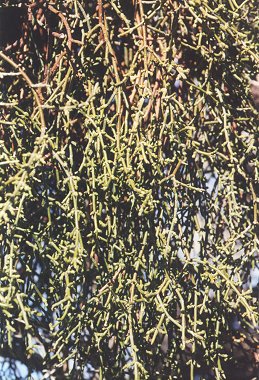The Desert Mistletoe is a leafless plant
with a dense cluster of jointed stems.
 They
are partial parasites, which have chlorophyll & can undergo
photosynthesis, but take water and nutrients from the host plant. The
plant relies mainly on leguminous trees and shrubs such as paloverde,
mesquite, ironwood and acacia. You can usually spot mistletoe as a
dense, green cluster in the branches of these plants. Over time, it may
kill the host plant by invading the bark and sap with its roots. They
are partial parasites, which have chlorophyll & can undergo
photosynthesis, but take water and nutrients from the host plant. The
plant relies mainly on leguminous trees and shrubs such as paloverde,
mesquite, ironwood and acacia. You can usually spot mistletoe as a
dense, green cluster in the branches of these plants. Over time, it may
kill the host plant by invading the bark and sap with its roots.
|
There are over 1000 species of
mistletoe in the world, almost all are partial parasites. |
Mistletoe is found in desert areas below 4000 feet
in elevation from southern Nevada, California and Arizona to Mexico. The plant blooms
in the spring, producing inconspicuous yellowish flowers followed by
pink berries. Native Americans ate this fruit as do Silky Flycatchers,
which rely on the berry as its main source of winter food. The seeds of
the berries are extremely sticky, and the birds propagate the plant when
they wipe their bills on another tree or when they excrete the seeds.
Note: the white berries of a related species, the Big
Leaf Mistletoe are bitter and poisonous. Don't go out and start eating
wild plants unless you know for sure what you're putting in your mouth.
|

